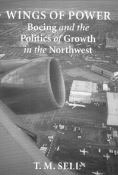As the old saying goes, if Boeing gets the sniffles, Seattle catches the flu. So what does Renton get, ebola? Wings of Power by T.M. Sell is a look at the past and future impact of the aerospace giant on our vaunted quality of life, and it could not be more timely. In recent weeks, headlines have trumpeted that the company is about to tip a few dominos that may shake up the region. In January, Boeing confirmed that it is considering closing the Renton plant and consolidating some of its aircraft manufacturing in Everett, a move that would have major consequences for King and Snohomish counties—not to mention Renton, the city that put the blue in Boeing’s collar.
Wings of Power: Boeing and the Politics of Growth in the Northwest
by T.M. Sell (University of Washington Press, $24.99)
On the heels of that shocker, company Chair and CEO Phil Condit, fresh from meetings with fellow members of the global economic elite in Davos, Switzerland, felt the need to remind us that Boeing cannot be too reliant on one region—or one national economy—for its future. As it roams the world for customers, cheaper workers, and more Boeing-friendly manufacturing environments, the company’s attachment to its hometown may be less of an asset than in the past. That some “wings of power” are soon going to be manufactured in Japan seems likely.
Boeing is genuinely responding to the competitive marketplace: In order to slay the Airbus beast, the company must be more nimble and opportunistic. To do that, Condit believes Boeing must be less American. Its economic loyalties, after all, are to itself and its shareholders, not to the folks back home in Seattle. Free trade brings down international boundaries, but it also loosens the national and regional loyalties, especially those of the mega-multinationals (part of what all that WTO fuss was about).
But, as T.M. Sell tells us, Boeing is also playing the very old game of reminding us of its importance by threatening to move to Wichita, Huntsville, or California. Although these threats should not be mistaken as empty ones, they are as regular as the airline industry’s up-and-down cycles and are issued to gain public sympathy or political concessions. As Sell points out, Boeing has never really needed Seattle specifically; it could have flourished anywhere, much like Microsoft. The fact that it’s here is largely just luck of the draw.
Of course, after decades of investment, building a regional workforce, and crafting a tax code and political environment much to its liking, Boeing is largely comfortable here. Its own employees are loath to move, and many even hold elective office. Not only that, but the company still commands multigenerational loyalties from many of its workers (Sell himself grew up in a Renton Boeing family). It’s literally part of the fabric of life.
Despite Boeing’s roots, success, and clout, the company is never satisfied; it is continually looking to hone its competitive edge and improve its bottom line. Its needs—and demands—are constant, and threats to move or globalize provide important leverage.
That leverage is somewhat diminished, Sell points out, in that Boeing is now a smaller fish in our slightly larger pond. The once 800-pound gorilla now weighs in at around 450. Seattle, formerly America’s largest company town, has sprouted a silicon forest and trend-setting retailers, and seems irresistible to immigrants seeking a “quality of life” that eludes them elsewhere.
That quality of life is sometimes seen as endangered by the likes of Boeing. Seattle’s love-hate relationship with growth catches us in a “Growth Paradox,” says Sell: We work hard to promote a booming economy and prosperity, but then become sickened by the results as we face terrible traffic, LA-style sprawl, and unaffordable housing. So we turn on the golden goose. When we’re mired in growth’s difficult consequences, Boeing’s threat of bolting the region seems less unappealing and downright survivable. Let it move to Huntsville if it will unclog our roads.
But Sell makes the case that Boeing, like it or not, is still a crucial part of the state’s economy, which has largely been built around the company’s needs. We are heavily reliant on the taxes it pays, the jobs it provides, and the largesse of its charitable gifts and generous employees. Even Eastern Washington, with its (historically) inexpensive hydropower and low-cost aluminum-producing plants, is tailored by Boeing’s needs. Sell argues that neither taking the company for granted nor eroding our quality of life is an acceptable option—let alone good public policy. So can a balance that preserves lifestyle and accommodates the demands of growth be found and maintained? A way that would keep Boeing, and the rest of us, happy?
Sell attempts to answer that question by looking at Boeing’s history, particularly as it relates to the development of the region. He focuses on the recent past—the 1990s, when the state implemented the Growth Management Act. The GMA was supposed to allow us to grow sensibly, to funnel growth into designated zones and require communities to plan for the future. It asked developers to build infrastructure in tandem with development, and it attempted to preserve rural areas by steering would-be suburban sprawl into urban villages. It sounded good, perhaps an answer to Sell’s Growth Paradox, but both the intended and unintended consequences have been problematic: Seattle rebelled against urban villages, housing prices have skyrocketed, and gridlock prevails.
Sell looks at the messy politics and flaws of the GMA, and suggests a more moderate path that is less about controlling growth per se and more about fixing systemic problems. It includes investing in infrastructure (mass transit), instituting major tax reform (an income tax), streamlining the decision-making process (such as permitting), and electing bolder political leadership that is not afraid to compromise. Such a plan might prove to have popular support as well as the support of Boeing, which has always had a fairly sophisticated—if self-interested—view of public policy. Other members of the growth lobby would likely follow. Sell’s appeal harks back to the kind of nonpartisan regionalism espoused by Jim Ellis or Dan Evans, who was interviewed for the book.
Sell’s critique is largely business-biased, written from the standpoint of a reporter (he covered Boeing for the Valley Daily News and the Seattle Post-Intelligencer) who has actually read many of those massively dull roundtable reports and planning white papers that glaze the eyes of most journalists (he even slogged through the “Peirce Report”). While far too dismissive of growth skeptics—virtually none are interviewed and those discussed are usually framed as clueless gadflies—Sell offers some very interesting insights into Boeing’s history as a regional giant, and he suggests what the rest of us can do to harness the gorilla, if not tame it, for our long-term benefit.







